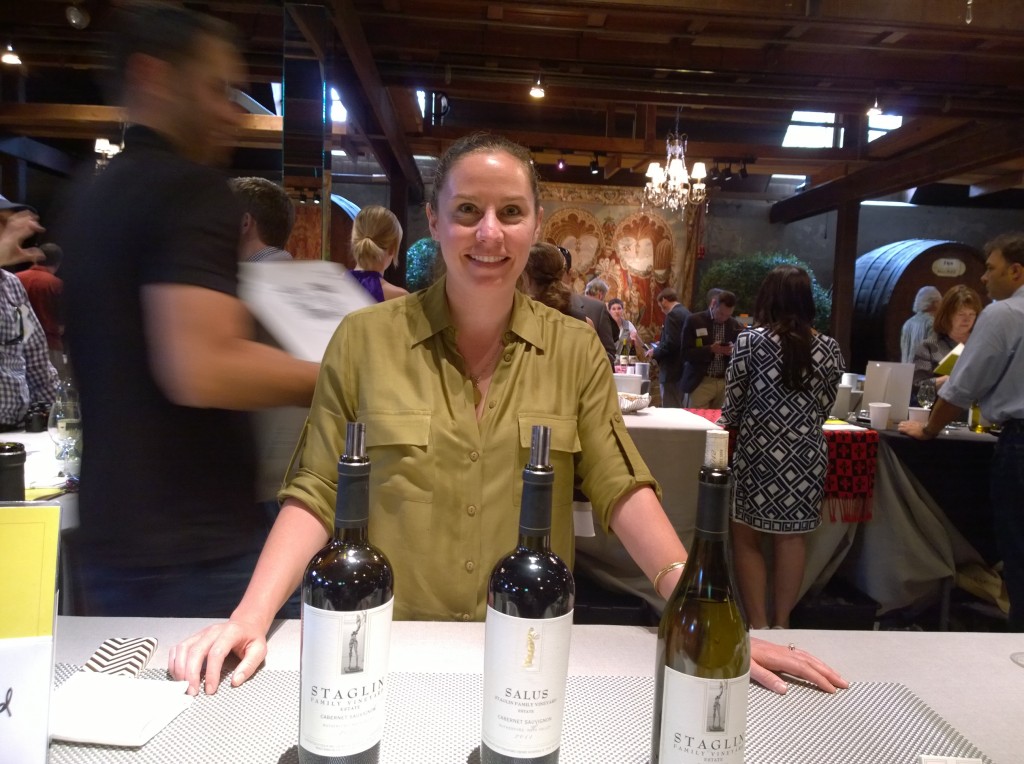For Rutherford Vintners, the Cool 2011 Vintage Was a Winegrower’s Year
 Photo by Jason Tinacci/Napa Vintners
Photo by Jason Tinacci/Napa Vintners
I remember one rainy October chatting with Stephane Derenoncourt and asking if he was concerned about the next storm front. Would he be rushing to harvest his Napa Valley grapes before then? He just smiled and said “No, I’m from Bordeaux.” In France, winemakers are accustomed to working with unpredictable weather throughout the growing season, spending as much time in the vineyards as in the cellar, hence the term vignerons, or winegrowers. But for many Rutherford vintners, the cool 2011 vintage marked by an unusually rainy October and ensuing rot in some places was something they’d never seen in their careers, or at least for the more seasoned vintners, since 1982. From a tasting of Cabernet Sauvignon at the Rutherford Dust Society’s Day in the Dust gathering last Wednesday it was clear that in 2011, Rutherford vintners became winegrowers in the true sense, the wines reflecting key decisions in the vineyards, at harvest and in the cellar that would ultimately highlight the best aspects of the cool vintage: purity and freshness.
A Cool Vintage Enhanced by Low Yields, Sun and a Late Harvest

A rainy spring through June delayed bloom and disrupted flowering, setting up for a lower-yield vintage. Overall, the growing season was cool, like 2010, allowing the grapes to ripen slowly to develop complex flavors. At the same time according to Shannon Staglin of Staglin Family Vineyards, there was a normal amount of sunlight hours, allowing the tannins to ripen without a lot of sugar accumulation. I could taste the fine balance of concentration and freshness in the 2011 Staglin Estate Cabernet Sauvignon ($190).
A pivotal point in the growing season occurred in early October when nearly half an inch of rain fell, creating perfect conditions for mold, rot and botrytis. It was a year, said Tom Rinaldi, Director of Winemaking at Provenance Vineyards, where “jumping the gun” to harvest in anticipation of the rains, or waiting it out with nerves of steel, would affect the final expression of the wines.
Great Wines Begin in the Vineyard

Michael Scholz at St. Supery Estate dropped more fruit during this cool vintage “to speed ripening”. They waited through the early October rains, then selectively thinned fruit. After harvesting fruit between mid-October and November 1, the grapes were double-sorted for quality. At the end of the day, Scholz said they dropped twice as much fruit as usual in this vintage. The wines were then made in open-top fermenters using gentle punchdowns. The result, the 2011 St. Supery Rutherford Estate Vineyard Cabernet Sauvignon (340 cases, $100), is a wine of real finesse.
Severe selection of fruit at harvest and double and triple sorting in the cellar was definitely critical for all of those vintners who harvested after the rains, but patience showed its virtues in terms of concentration and ripe tannins.
The Winemaker’s Touch

In my notes for the 2011 Georges de Latour Private Reserve Cabernet Sauvignon (5,600 cases, $130) I wrote, “velvety, ripe, integrated tannins” which begins in the well-draining soils of Beaulieu Vineyards Ranches No. 1 and 2. Winemaker Jeffrey Stambor attributes the wine’s rich texture and fine integration of oak in part to barrel-fermenting 40% of the wines (the remainder in conventional stainless steel and wood vats). He also increased the amount of Petit Verdot in the blend to add color and structure. On balance, the wine had the classic black currant flavors, herbal lift and freshness of Bordeaux combined with a density of Rutherford fruit that was carried by lush tannins. A wine of true elegance.

Mike Smith, a self-taught winemaker who learned a lot about experimentation from Thomas Rivers Brown, has a different take on barrel ferment. He makes the wine the conventional way in large vats but presses before completion, fermenting the final 8-10 g/l of sugar in barrel for finer integration of oak and rich mouthfeel. He finds completing fermentation this way slows down alcohol production and increases glycerol. The 2011 12C Beckstoffer Vineyard Georges III Vineyard 100% Cabernet Sauvignon wine (91 cases, $78) is a plush, fruit-driven but well-balanced wine, full of blackberry, cassis and blueberry fruit with classic Rutherford Dust notes of cocoa and mocha. The expression of this wine originates in the volcanic soils in the central/east part of the AVA.
Barrel fermentation is becoming more common but still constitutes a small percentage of production in the Napa Valley. For Philippe Bascaules, GM of Inglenook, it doesn’t make sense to barrel-ferment because they tend to pick their fruit on the early side of ripeness for the utmost expression and elegance in their flagship Rubicon. The oak from barrel fermentation would dominate such delicate fruit, and he was right.
2011 was a winegrower’s year.
For more information on the Rutherford Dust Society, check the website and to taste the wines, visit during one of their annual passport weekends.
